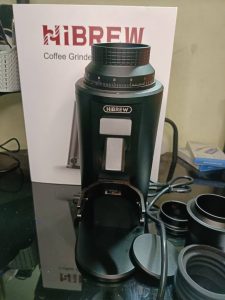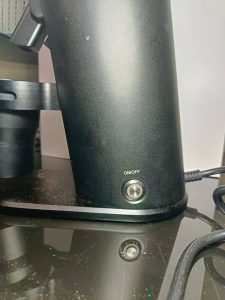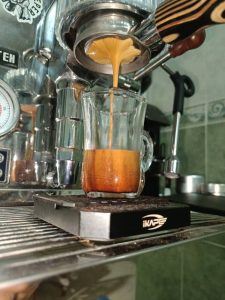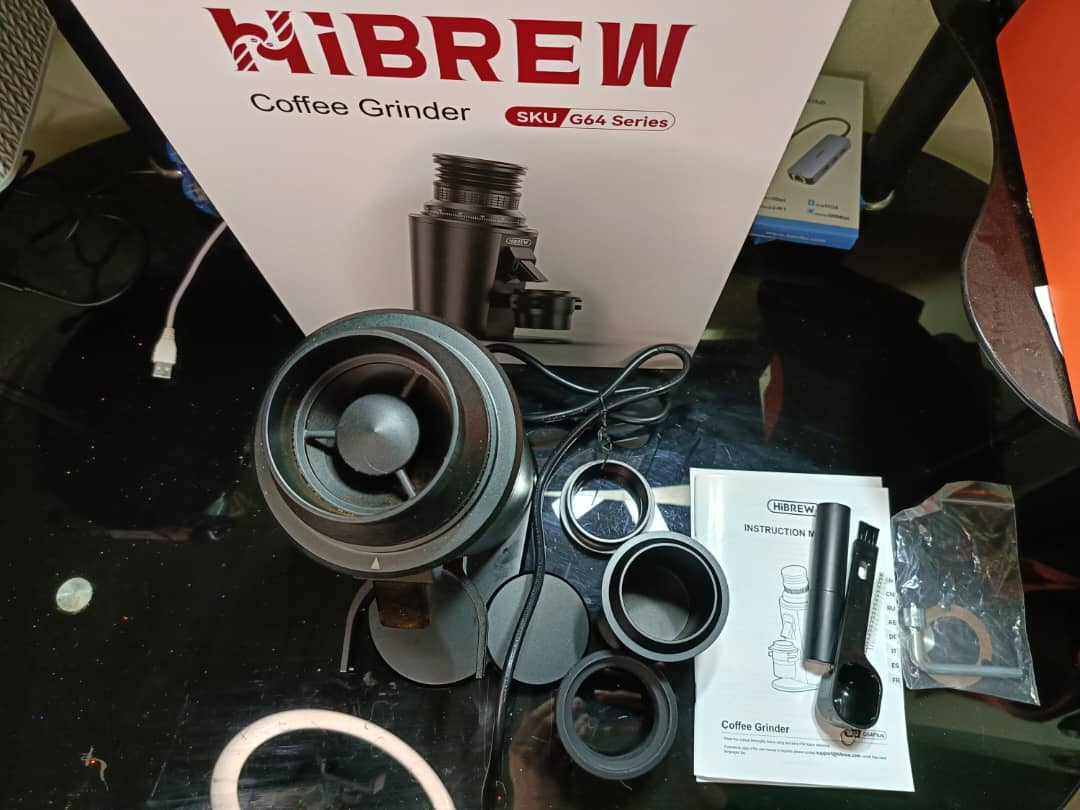If you’re a serious home-barista or an enthusiast looking to upgrade your coffee grind game, the HiBREW G64 Plus makes a strong case for itself. This review will examine the machine from top to bottom—its features, performance, pros and cons, suitability, and ultimately whether it’s worth the investment.
✅ What comes in the package
If you order the G64 Plus, you should receive:
The main grinder unit (HiBREW G64 Plus) — the grinder body with 64 mm titanium-coated flat burrs and brushless motor.
Dosing cup (aluminum-alloy dosing cup) — used for collecting ground coffee or single-dosing beans.
Powder blower (bellows / powder blower / “blow-out” tool) — this helps purge leftover grounds and promotes low retention / zero-waste single-dosing workflow.
Magnetic dosing ring — helps with dosing when using a portafilter, and reduces spillage.
Measuring scoop — to measure beans for dosing or pre-measure ground coffee.
Cleaning brush — for maintenance, to clean out burrs or the grinding chamber.
User manual / warranty card / documentation — instructions on use, maintenance, settings, and warranty info.

The Kickstarter page for the G64 Plus is the primary “official” purchasing channel.
1. Brand Background & Context


HiBREW is a company that has made a mark in the home coffee appliance space, with several successful crowdfunding efforts via Kickstarter. According to their blog, they have “successfully funded 5 projects, delivering top-notch products to 10K+ backers.”
The G64 Plus is positioned as a “premium” grinder in their lineup—designed for coffee lovers who “refuse to compromise and seek perfection.” So it’s geared toward those who care about grind quality, workflow, and control—not just entry-level convenience.
2. Key Specifications & Features

Here are the headline features of the G64 Plus, as pulled from HiBREW’s own marketing and spec sheet:
- Motor: 380 W high-power brushless DC motor. According to HiBREW, this ensures “constant high speed, preventing RPM drop even with dense beans.”
- Burrs: 64 mm stainless steel flat burrs with a titanium coating. These are designed to “slice, not crush” beans, for better uniformity and less heat.
- Adjustment: 150-level stepless adjustment dial, enabling a wide and precise range of grind settings—from very fine (e.g., Turkish) to coarse (e.g., pour-over) brewing. Variable speed control from approximately 600–1600 RPM is quoted.
- Anti-static tech: Inner & outer dual-layer anti-static system—described as a dual-plasma system for “active ionization + passive shielding” of static electricity at both the grinding chamber and outlet. The goal: reduce mess from static cling and retained grounds.
- Detachable Magnetic Powder Outlet: A feature that allows tool-free removal of the outlet portion of the grinder for cleaning, helping avoid stale residue which could impact flavor cleanliness.
- Bracket & Dosing Setup: A highly compatible stand supports most 58 mm portafilters; includes an aluminum alloy dosing ring to reduce spillage during dosing.
- Hopper and build details: The Kickstarter page mentions features like anti-slip dial engraving, aluminum alloy hopper lid, 60 g hopper capacity, aluminium handle bracket, aluminium dosing cup.
These specs place the G64 Plus firmly in the “serious home grinder” category—especially with a 64 mm burr size and brushless motor, both of which are features usually associated with more premium machines.
🔧 What is RPM (in a coffee grinder)
RPM = “Revolutions Per Minute” — how many times the burrs inside the grinder rotate each minute. It describes the rotational speed of the grinding burrs. Wikipedia+1
In electric grinders, RPM determines how quickly beans pass through the burrs and how violently (or gently) they are cut. High RPM means more rotations per second → faster grinding; low RPM means slower, more controlled grinding.
In the case of the G64 Plus, the manufacturer states it has variable speed control from 600 to 1600 RPM.

✅ Why variable RPM matters — what speed affects
Adjusting RPM gives you more control over the grinding process. Specifically, changing speed can affect:
• Particle size distribution & uniformity
Research and expert commentary suggest that grind speed changes how grounds distribute — faster speed can lead to more fines (very small particles), whereas slower speed tends to yield a narrower, more uniform particle size distribution.
Uniform grounds help with consistent extraction. If particles vary widely in size, water extracts some too quickly (small particles — over-extraction) and some too slowly (large particles — under-extraction), leading to imbalance in flavor.
• Heat and static generation during grinding
Grinding at high speed generates heat and friction, which may affect flavor: the heat can accelerate loss of volatile aromatic compounds in the coffee beans. Some sources claim slower grind speed preserves more delicate aromas and yields a cleaner cup.
Additionally, slower grinding tends to reduce static and “fines clinginess,” improving cleanliness and dose accuracy. This may help especially for single-dose grinders, where you want minimal retention.
• Flexibility across brewing methods
Because different brew methods demand different grind characteristics — fine and consistent for espresso, more coarse and forgiving for pour-over or French press — variable RPM lets you optimize for each method:
| Speed (RPM) / Lower → Higher | Likely Use Cases / Effects |
|---|---|
| Lower RPM (~600–~1000) | More uniform grind, less fines/heat → good for pour-over, drip, light roasts, delicate flavour clarity |
| Mid RPM (~1000–~1300) | Balanced grind & throughput → might suit methods like Moka pot, Aeropress, medium roasts |
| Higher RPM (~1300–1600) | Faster grinding, possibly more fines → useful for espresso, darker roasts, faster workflow |
This aligns with broader commentary from grinder-experts: variable-speed grinders give “more control and precision” for different brew goals.
🎯 What that means in practice for G64 Plus
Because G64 Plus exposes a wide speed range (600–1600 RPM), you — as user — have the ability to tune your grind not just by adjusting burr gap, but by adjusting speed. This gives you:
Greater versatility — you could dial in a grind profile for espresso in one session, then switch to pour-over or drip the next, without swapping grinders.
More fine-tuning potential — combining the 150-level stepless burr adjustment with variable RPM creates a large “matrix” of grind settings (burr gap × speed) to calibrate for bean type, roast level, and brew method.
Ability to experiment — if you like tweaking and optimizing, speed adds a dimension to “dialing in” your coffee beyond just grind size.
However — and this is important — RPM is not a magic bullet. The optimal speed depends on burr design, bean density, roast, brew method, and even ambient conditions. It’s a tool for control, not a guaranteed “better cup” slider. Many grinder-experts note that slower vs. faster RPM may change particle distribution, heat, fines, but taste outcomes remain somewhat subjective.
🧪 How to use RPM on G64 Plus — basic guidelines
If you get the G64 Plus and you want to experiment with RPM, here’s a simple starting approach:
Espresso → Start around higher end (1300–1600 RPM) + fine burr setting. Adjust finer/coarser until you get the desired extraction.
Pour-over / drip / filter → Try lower RPM (e.g. 800–1000 RPM) + appropriate burr setting; aim for clarity, sweetness, fewer fines.
Medium-roast / Moka / Aeropress → Test mid-range (1000–1300 RPM) to balance throughput and grind consistency.
Keep notes — Record brew method, roast, bean type, RPM, grind setting, extraction time, taste notes. Over time, you can find your “sweet-spot” combinations.
Clean and calibrate — Because speed affects heat and fines/static, regularly clean burrs/outlet; this helps maintain consistency between sessions.
3. Design, Build Quality & Ergonomics



From what can be observed, the G64 Plus’s design leans toward industrial aesthetic with practical touches. The large 64 mm burrs and the robust motor suggest a sturdy build. The titanium-coated burrs indicate an intention toward durability and consistent performance over time.
The anti-static system is a thoughtful addition, especially for home users who may struggle with spattered grounds or clingy powder around the grinder. Having a detachable magnetic outlet also makes cleaning more convenient, which can significantly improve the user experience.
The dial for grind adjustment being stepless and covering 150 settings means the ergonomics of adjustment matter. The presence of anti-slip engraving and good tactile feedback will matter for frequent users. The bracket adaptable to 58 mm portafilters means it’s designed with espresso machines in mind (common 58 mm size) rather than only filter or drip users.
On the flip side, we should consider the size and footprint: a 64 mm burr machine with a serious motor will likely occupy more counter space and possibly require more stable surface and sound insulation than light duty grinders.
4. Grinding Performance & Precision


Uniformity & Speed:
The large burr size (64 mm) typically improves both speed and uniformity of grind. Larger burrs can grind more quickly with less heat buildup, provided the motor delivers consistent torque—here, the 380 W brushless motor is designed to handle dense beans without RPM drop. This is an important factor if you switch between bean types (hard vs soft) or roast levels (light vs dark) because RPM drop can increase fines or inconsistent grind if the motor struggles.
Adjustment Range:
The 150-level stepless adjustment gives an impressive range. This allows finer tuning of grind size than many simpler grinders with say 40–50 settings. For an experienced user brewing espresso, or even dialling in for different roast profiles, this is a big plus. The variable speed range (600–1600 RPM) adds another dimension of control: slower RPM can reduce heat and preserve aroma, faster RPM can speed the workflow for bulk grinding.
Anti-static & cleanliness:
The dual-layer anti-static system is beneficial for reducing retained grounds, static cling and mess. Less residual powder means fewer old grounds mixing with new, which is important for flavor clarity. It also means less cleanup—and less likely that fine powder will end up on surrounding surfaces.

Dosing & workflow considerations:
The bracket for 58 mm portafilters means when you are grinding for espresso you can place your portafilter directly in front of the chute/dosing ring, reducing spillage. This helps workflow and reduces waste. The magnetic outlet is a nice feature for maintenance. Having consistent cleaning and maintenance means the grinder will maintain performance over time.
From a performance standpoint, these features combine to form a strong value proposition for users seeking high-end grinding control at home.
5. Use-Cases & Suitability
Best for:
- Home baristas who brew espresso (likely 58 mm portafilter size) and want a high level of control and performance.
- Users who grind multiple brew methods (espresso, filter, pour-over, maybe even Turkish) and want a single grinder that can adjust across a wide range.
- Coffee enthusiasts who care about things like grind uniformity, static control, minimal heat/retained aroma, and easy maintenance.
- Users whose budget allows a premium grinder and who have the counter space and workflow to incorporate it.
Less suitable for:
- Casual users who only brew drip coffee or seldom adjust their grind; they may not benefit fully from premium features.
- Those with extremely limited counter space or who need ultra-compact or very quiet machines (though we don’t yet have specific decibel data).
- Users on a tighter budget who might find lower-cost grinders more than sufficient for their needs.
6. Strengths & Highlights

- Large burrs + powerful motor: The combination of 64 mm burrs and 380 W brushless motor means speed and consistency, with less risk of slowdown or overheating.
- Fine adjustment precision: 150 settings stepless adjustment allows very precise tuning, which is especially valuable for espresso and roasting variation.
- Anti-static design: Reduces mess, waste and flavor contamination from retained grounds—often overlooked but very practical.
- Good workflow features: Portafilter compatibility, dosing ring, magnetic outlet—all enhance day-to-day usability.
- Durability in design: Titanium-coated burrs, brushless motor (longer lifespan) indicate the machine is built for sustained use rather than just occasional.
- Brand’s proven crowdfunding track record: HiBREW’s previous success gives some confidence in delivery and support.
7. Potential Weaknesses & Considerations
- Price-point: Premium features come at a premium cost. The Kickstarter pricing posted included $329 for the brushed motor version (early bird). Non-early-bird pricing may be higher. For some users this may be a significant investment.
- Footprint & acoustic output: A machine with a large burr and high power motor may be louder or take up more space. If your setup is in a small kitchen or you value low noise (e.g., early morning coffee), you need to check how it actually performs in your environment. (HiBREW doesn’t provide dB data in the spec sheet I saw.)
- Real-world review data limited: While we have manufacturer specs and marketing material, independent long-term user reviews (particularly from non-crowd founding backers) are not abundant yet. That means some risk in “how it performs over time” remains.
- Complexity for casual users: With 150 settings and advanced controls, users who just want “set it and forget it” may find it more complicated than simpler grinders. Calibration and workflow discipline will matter if you want to get the full benefit.
- Availability & shipping: Because this is a Kickstarter launch product, availability in retail channels, shipping to various countries (including Algeria) and after-sales support may differ compared to more established grinders. HiBREW’s blog notes shipping overseas but with longer timelines.
8. Comparisons & Market Positioning
While this review is about the G64 Plus, some context is useful. Many high-end home grinders have features like large burrs, stepless adjustment, and anti-static systems. What the G64 Plus appears to do well is combine many of those premium features into one machine at a potentially more competitive price point (given early bird pricing). The 64 mm burr size puts it above many “mid-tier” home grinders that may use 50–58 mm burrs.
For example, if you compare with other grinders aimed at serious home baristas (50-60 mm burrs, step vs stepless adjustment, standard motor vs brushless, etc.), the G64 Plus seems to offer a robust spec list. The anti-static dual-layer system is less common in many home grinders and may give an edge for cleanliness and flow of process.
In terms of workflow for espresso, the compatibility with 58 mm portafilter and good dosing features mean it positions well for the home barista who invests in an espresso machine alongside it. If your focus was purely pour-over or drip, you might find the extra features less essential—though you’d still benefit from grind uniformity and control.
9. What the User Experience Might Be
Based on features and brand claims, here’s what you can reasonably expect from daily use of the G64 Plus:
- You’ll likely be able to switch between brewing methods more easily: e.g., fine espresso grind to coarser filter grind, thanks to the broad adjustment range.
- Dosing and workflow should be smoother with the bracket, dosing ring, and magnetic outlet—less fuss, less mess, fewer spillages.
- Cleaning and maintenance may be more convenient than some other grinders—anti-static system and removable outlet reduce “powder-everywhere” problems which many grinders suffer from.
- With a powerful motor and large burrs, you should get faster grinding without as much heat or drop in RPM when handling denser beans—important for consistent extraction and flavour retention.
- Over time, the titanium-coated burrs and brushless motor likely mean better durability and longer life, assuming routine maintenance is done.
- On the flip side, you might need to spend time setting up and calibrating: brute specs don’t automatically equal ease of use for everyone. You’ll want to calibrate your dosing, re‐set the grind dial and test extraction/skim settings, especially if you change beans. So there is a “learning curve” to leverage the full potential.
10. Final Verdict
If I were to sum it up: The HiBREW G64 Plus is an impressive grinder that brings premium features into the home setting. For the passionate home barista—especially one using espresso machines and taking grind quality seriously—this machine offers a compelling mix of power, precision, control, and workflow features.
However, it’s not a one-size-fits-all solution. For casual coffee drinkers, or those who use simple drip machines and rarely adjust grind size, this may be more grinder than necessary (and cost more than simpler models) without fully leveraging its advantages.
So my verdict: recommended for serious users who want a high-end home grinder with features that scale up; less recommended (or you might want to hold off) if you simply want a “good enough” grinder or are just starting your journey and might later upgrade once you’ve grown into more advanced workflow.
In short: if you want to future-proof your grind setup, invest in control, and have the space and budget, the G64 Plus is a standout. But if you’re just brewing a cup or two a day and don’t plan to tweak grind size often, you might consider something more budget-friendly and still very capable.
11. Suggestions / What I’d Like to See
A few things I’d like to see improved, or at least clarified in future iterations or long-term user data:
- Noise and heat output measurements: Quantifying how loud and how much heat is generated during heavy grinding cycles would help compare to competitors.
- Real-world uniformity tests: Data (e.g., particle size distribution graphs) comparing the G64 Plus to other grinders would help substantiate claims of “slice not crush” burrs.
- Service/parts ecosystem: As this becomes more common, ensuring that burr replacements, motor service, calibration tools, and documentation are widely available will increase long-term value.
- User interface refinements: For example, if the grind dial has clear markings, indexing, or stop-points—especially helpful when adjusting for espresso then switching to filter grind.
- Regional support: In markets like Africa/MENA, local distributor support or regional service centres would boost confidence for buyers outside the U.S./Europe.
Where to get it right now
The Kickstarter page for the G64 Plus is the primary (and currently only) “official” purchasing channel. That’s where HiBREW is offering early-bird pricing and collecting orders.
On HiBREW’s own site: though the G64 Plus is described there, the store currently links back to the Kickstarter campaign as the way to back/reserve it
13. Conclusion
If you’re reading this review and asking: “Should I get the HiBREW G64 Plus?”, here’s the takeaway: Yes—if you’re committed to precision, care about grind quality, use espresso (or multiple brew methods), and are willing to invest in a serious piece of equipment. The G64 Plus checks many of the boxes for a high-end home grinder.
On the other hand: If your coffee habits are straightforward (just drip/automatic machine), or if your budget is more modest, you might be better served by a simpler grinder that meets your needs without costing as much or requiring as much calibration/workflow effort.
In short: the G64 Plus is a great investment for the right user. It’s perhaps overkill for casual use, but for someone who wants excellence and is willing to engage with the workflow, it delivers.



